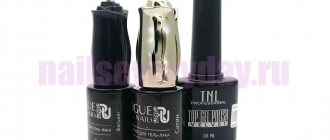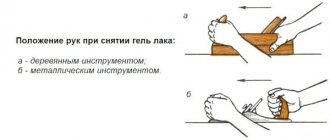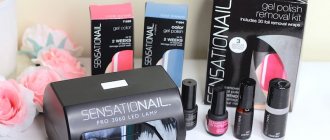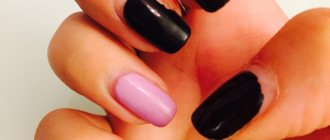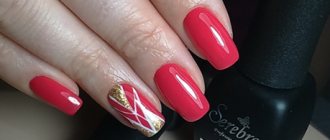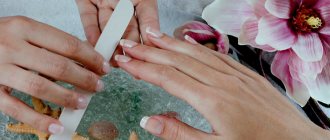Not all lovers of regular manicure use a base coat and sealer. But in vain, because the nail polish fixer not only makes the nail polish shine, but also protects it from various external influences, such as water when washing dishes or the sun's rays on a hot summer day.
What is a gel polish topcoat?
Top or finish, fixer, top coat is the top coat, the third phase in a three-phase system, the final stage in the procedure of applying gel polish to nails. First, the nails are covered with a base coat, then with colored gel polish and finally a top coat is applied. Each layer is polymerized separately. The finish is applied in a thin layer or with a slight leveling of highlights, but it is never used to strengthen the nails. Sometimes a design is made on top of the finishing coating, for example - gel modeling, three-dimensional painting, convex decor, loose glitter, etc.
Newbie mistakes: why the product does not apply evenly
The varnish sealer may apply unevenly if the product begins to thicken. When working, it is necessary to stretch the composition over the nail. In case of unsuccessful applications, you should add a little more product and try to start coloring from the center of the nail.
If the texture is light, moderately liquid, this mistake will not happen. The main thing is not to overdo it and not to push the material close to the root part. In any other cases, you can use an orange stick, which can easily eliminate leakage into the side rollers and onto the cuticle.

Matte topcoat or dryer should not be applied in a thick layer. This will cause the material to lie unevenly and there will be bumps on the nails. Top coats with a thick base, on the other hand, should be applied in a thick layer and spread over the plate like a regular clear coat.
What types of nail tops are there?
Classification of finishing coatings is made on several grounds, that is, on a number of unrelated characteristics. They affect the speed and ease of working with the material, the application technology and the range of tasks to be solved. The most important signs are:
- Glossy top or matte;
- With or without residual sticky layer;
- Elastic or hard;
- Thick or liquid;
- Turns yellow or blue;
- Whether it bubbles or not;
- Resistant to damage and rubbing or not;
- Specialized or general purpose;
- Decorative top or classic fixative.
Glossy and matte top: is there a difference in application?
Classic fixatives in the gel system have a glossy shine. Manufacturers are competing for the hearts of craftsmen, developing materials with an ever brighter and more durable gloss. The brighter the gloss and the smoother the highlight, the more expensive the manicure looks. Therefore, clients often choose the specialist whose coating shines better and lasts longer.
A few years ago, matte tops . And here, too, a wide choice is provided - the degree of matte varies from a smooth satin shimmer to the velor effect of an anti-slip surface. You can find names like these: satin, velvet, corduroy, velor, cashmere.
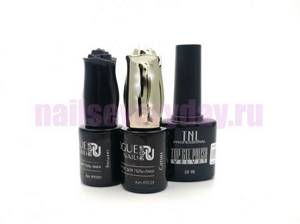
The nuances of using a matte finish. How to properly apply matte top over gel polish
- Often this finish serves only a decorative function. Therefore, before applying it, for reliability, it is better to cover the nails with a regular gel polish fixer with residual stickiness, dry, remove the stickiness and apply a layer of matte top;
- Matte finishes actively absorb dyes and fats, rub off and begin to shine after just a week of wear, so they require care. They are not suitable for colorists, chefs, artists and anyone whose hands are subject to heavy workload. If the matte top gets dirty, you can clean it with a cotton pad soaked in alcohol. Do not use acetone, it will dissolve the gel polish.
- The more velvety the matte top, the more it feels on your hands, like it’s “braking” the entire surface. For girls with high sensitivity, we recommend choosing satin tops - they will provide a fashionable lack of gloss and will not irritate.
Reviews
Many women periodically use nail polish fixer. Reviews about manicure fixing products are mostly positive. Women noted the immediate effect and improvement in the appearance of the varnish coating. After applying the fixative, the manicure lasts longer and does not chip when performing various tasks every day.
According to women, the fixative replaces a salon manicure and is a cheap alternative. Nails painted at home and treated with a fixing liquid have a beautiful shine and look neat.
Finish with or without tack. What is the difference
“Sticky” - the dispersion layer consists of material components that were not included in the polymer and did not evaporate in the lamp, but remained on its surface.
Tops for gel polish with a sticky layer
Classic gel polish finishes - soak off top coat, finish gel. In conventional topcoats, the dispersion is not sticky, but rather slippery, it has no functional load and must be removed.
Do not wipe off the sticky layer as soon as you remove your hand from the lamp - let the top cool a little. Otherwise, you can leave unsightly marks from the napkin on the hot surface.
The dispersion should be washed off carefully, without smearing it on the skin around it. For each nail, use a clean, lint-free tissue or the unused side of it.
After moistening it in liquid to remove the sticky layer or in alcohol, apply the napkin to the surface of the nail for a couple of seconds and remove it towards you. Due to such careful removal of the dispersion, the risk of allergies is reduced.
In specialized finishes, for example, tops for sliders, the dispersion can be very sticky - it helps to fix the decor and is preserved by covering it with another layer of a regular finish on top.
Gel polish tops without sticky layer
Widely used family of finishing coatings. No wipe top coat, no cleanse top coat, non-cleansing gel top, finish gel without sticky layer, top without l/s - all these are variants of the names of the material, all components of which are part of the final polymer, without the formation of a dispersion layer on the surface.
The no-tack finish has a brighter shine and is quicker to apply as there is no time required to remove the dispersion. Previously, such materials were considered fragile, but thanks to the development of technology, this problem has gone away. The main thing is not to overdry them much longer than the time recommended on the bottle, since with every minute in the lamp they become more compacted and stretched. You can safely choose them as the main fixative and enjoy the acceleration. Also, rubs are rubbed into such tops, broths and voluminous decor are secured with them.
Stage 2. Preparing the nail plate for coating
Next, you need to prepare your nails for a manicure with gel polish. This stage is very important, since it determines how well the adhesion of the natural nail and the artificial coating will occur. To carry out proper preparation, we will need the following materials:
- buff;
- brush or brush for removing dust;
- lint-free wipes;
- 2 in 1 liquid: degreaser and sticky layer remover - this product removes natural deposits (grease and dust) from the surface of the nail plate, thereby preparing the plate for better adhesion to the artificial material;
- dehydrator (nail-prep) - deeply dries the nail plate and removes excess moisture from it. A dehydrator is a must for people with oily skin and prone to excessive sweating, since usually the structure of their nails is damp and oily, which impairs adhesion to artificial turf;
- primer - translated as “primer”. There are acid-free and acidic primers.
The acid-free primer acts as double-sided tape and ensures strong adhesion of the natural nail to the artificial nail.
The acid primer lifts the keratin scales of the nail plate for better adhesion to the artificial material. Since the acid primer contains aggressive components, you must be careful not to get it on the skin and cause a burn. It is recommended to use it before extensions for girls with wet or oily nail texture.
What do we do at this stage?
- We treat the surface of the nail plate with a buff to lift the scales of the nail plate and improve adhesion.
- Remove dust with a special brush.
- Apply degreaser to a lint-free cloth and wipe your nails. If you want to make the process as comfortable as possible, we recommend using liquids without chemical fragrances, such as ParisNail liquids. They have pleasant aromas and 100% rid the nail plates of germs, grease and dirt, thus guaranteeing long-lasting wear of the coating.
- If you have oily skin, then to improve adhesion, apply a dehydrator to the entire surface of the nail and air dry for a minute.
- Then you need to apply primer to the free edge of the nail. The free edge is one of the most vulnerable places, and thanks to the primer, the adhesion between the nail plate and the artificial material improves, which contributes to longer wear of the coating. We also air dry the primer for one minute.
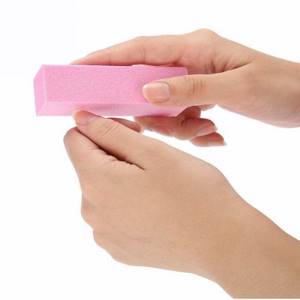
Fixer for gel polish: hard or elastic
Just like the base, the finish gel can have varying degrees of elasticity. Hard, rigid fixatives - hard top - can only be applied to artificial nails reinforced with hard materials or extended ones. If the base is soft and the top coating is hard, then with use it will crack like chocolate icing on jelly. Cracks and chips will appear, which will trap dust and dirt, which will greatly ruin the aesthetics.
Stretch tops are more versatile than hard tops as they can be applied to any surface. If you don’t know whether your finish is hard or plastic, you can check it this way: apply a strip of material to the film, polymerize it, separate it from the film and try to bend it. The hard one will break, the elastic one will crumple.
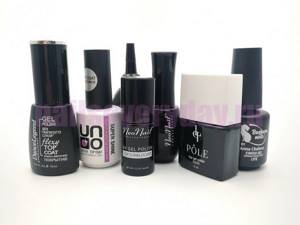
What is it: composition, properties
Any decorative coating is a complex chemical composition to which various microelements are added. The final coating for nails should increase the wear life of the decorative coating.
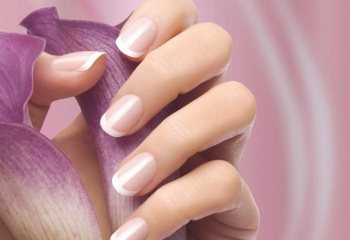
Since we live in the 21st century, in which innovations and advanced technologies appear, there are several types of fixative. Nail fixatives are based on gel materials or regular resins, which are added to a simple polish.
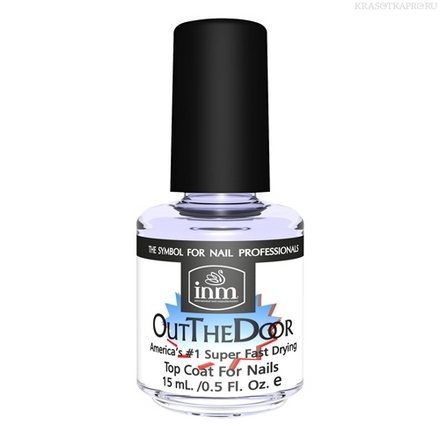
The durability of a manicure can be extended by a varnish that has a finishing touch. The same fixative that forms an additional protective layer on the surface that prevents chipping of the material and performs the function of gloss.
As a rule, after painting nails, a hydrophobic film containing colored pigment appears on the surface of the plate. Its structure is very vulnerable, so the slightest negative impact damages the enamel.
In order for the design to last long, you need to purchase a fixative. An additional layer of fixative provides protection to the pigment, enhances shine, and extends wear time.
A nail polish fixer may have the following properties:
- protects the plate;
- promotes rapid drying;
- adds extra shine;
- has a healing effect;
- is a means for fastening materials;
- fixes decorative varnish.
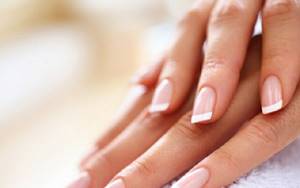
The fixative seems to impregnate all previously applied coatings. However, only those products that contain regular nail polish fixative. If we talk about polymer materials with a gel composition, then they have a different meaning.
Liquid or thick top. Which one for what
Liquid top for gel polish
Forms a drop on the brush in 1-2 seconds. Self-levels quickly, lays down in a thin layer and is suitable for experienced craftsmen who save time. Not suitable for fixing voluminous decor such as bouillons, rhinestones and studs. Beginners and those who apply the coating themselves often experience problems with leakage into the nail cavity.
Medium consistency top coat for gel polish
It forms a drop in 3-5 seconds. It is applied in a medium thickness layer and self-levels well. It can be called universal, as it is easy to use at any level of skill, on nails of any length and volume.
Thick top for gel polish
Forms a drop on the brush in 6-8 seconds. It is applied in a fairly thick layer, at least 0.5 mm, which adds volume to the coating and takes a long time to self-level. As a main fixative, it is interesting for complete beginners with no experience, as it does not spread and is suitable for slow motor skills. Experienced craftsmen use it to secure rhinestones, bouillons, studs, and for local application.
Can it be replaced with another product?

Replacement with acetone
Only a master during the procedure, after examining the condition of the nails, can correctly select the required type of primer. Ideal modeling and extension will depend on the correctness of its choice. And the appearance of your nails will attract attention for a long period of time. Do Giordani Gold Oriflame cosmetics really deserve the title of premium, find out in this material.
The gel polish top turns yellow or blue. Which finish to choose for black and which for white?
Any topcoat can turn yellow, regardless of the signs described above. Typically, yellowing becomes noticeable when applying a leveling finish over a light gel polish, when thickness appears. Yellowness can be either an intrinsic property of the material or the result of pigments from bright gel polish entering it. So, when red shades overlap, residual color dispersion gets onto the top brush, and as it accumulates in the bottle, the transparent material acquires a yellowish tint. This happens approximately in the second half of the bottle. We recommend wiping your brush after bright colors or getting a separate bottle of finish for light shades.
The “blue” finish is usually the opposite, on dark and bright colors and only in natural light, which contains ultraviolet light. This is due to the presence of UV filters in the material. Black gel polish can turn blue under bright sunlight, brown - purple, scarlet - crimson, etc. Therefore, for dark shades, we recommend choosing a top without UV filters. Whether it turns yellow or not does not matter.
For the cleanest and freshest jacket possible, as well as white and all light shades, get a strong blue top with UV filters. For example, without l/s: Bagheera Nails B-5 Lite or Uno Supershine. For black, dark and bright colors, choose a top without a UV filter, which may yellow slightly - it will not be noticeable. For example, top with l/s NeoNail Hard Top.
Bonus: “emergency room” for a ruined manicure
There are situations when the varnish or coating in excellent condition has chipped along the edge, but the nails grow and it becomes more and more noticeable. In this case, you need to update your manicure, but if you don’t have time, you can resort to temporary tricks that will extend the life of your manicure.
First secret. Apply a thin layer of paint only to areas where there are problems or where the nail plate has grown. Or immediately apply a clear glitter polish on top.
Second secret. Used for chips along the edges. Paint a thin strip with shiny varnish, as with a French coat. The manicure will have a well-groomed, updated look.
The gel polish top is bubbling. Who is to blame and what to do
Air bubbles in gel polish are a serious problem, since they do not disappear during polymerization and look sloppy on the surface of the material, like garbage. They appear due to sudden movements of the brush in the bottle, forcing air into the material. If you do not want to have aesthetic defects in the coating, then get used to smooth and neat, precise movements. Do not throw the brush into the bottle, do not shake the gel polish, do not stir it right before use.
There are materials that are more prone to the formation of bubbles; you should be extremely careful with these. There are less sensitive exceptions, but even with them you should not allow yourself unnecessary sudden movements. Check for bubbles before polymerization and, if found, carefully burst each one. To do this, lightly poke the bubble with the tip of a thin brush or orange stick.
How to choose the right nail fixer in the store?
Probably, many girls know very well how to choose a good nail polish in a store. They choose the tone, matte or glossy shine, comfort and length of the brush, and take into account other equally important factors. But no one thinks about how to choose the right top coating.
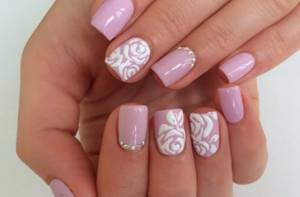
We list the most important qualities of such a product that you should definitely pay attention to: 1. Freshness effect . After application and for 5-8 days, the wet effect of the newly applied base coat should remain. If after 2-3 days the manicure looks worn out and “stale,” then you made a mistake in choosing the top coat.
2. Don't leave any bubbles. After the fixative is applied to a nail painted with the base coat, there should be no unevenness or bubbles left on the surface, and a high-quality product will lay down in an even layer. When purchasing, shake the bottle vigorously and paint one nail with top coat. Wait half a minute until the top layer dries and take a good look at the painted surface. 3. Dry quickly. This quality is given great importance, since modern women live at a frantic pace and cannot afford to waste time on slow drying of varnish. 4. “Bonus from manufacturers” . Manufacturers, attracting customers, add vitamins for nails and all kinds of protective substances (from delamination, “blooming”, etc.) to the composition of the product. This quality is not mandatory for a fixative, but it is so nice to know when using the product that it is not only beautiful, but also useful.
Gel polish top is rubbed off
Absolutely any top will be rubbed off . Glossy becomes matte, and initially matte begins to shine over time. Finish coatings from the premium segment retain an attractive appearance for up to 4 weeks of wear, while cheap ones can lose it after just a couple of days. This process occurs most quickly on the nails of the working hand: for right-handers - on the right, for left-handers - on the left. On the thumb, index and middle fingers. You can slow down the loss of appearance by strengthening your nails with hard materials: gel, acrygel, hard base. This will make the free edge motionless, which means it will bend and rub less. Strengthening will also prevent cracks, chips and detachments.
Fixer "Smart enamel"
Among the many existing means for fixing manicure, one of the most popular is the “Smart Enamel” nail polish fixer. This is a professional product with a therapeutic effect, which contains a complex of useful substances that help nourish and strengthen the nail plates. “Smart enamel” instantly dries nails and gives them a mirror shine.
This fixative helps restore even brittle and depleted nail plates. With constant use, nails become stronger and grow better.
The “Smart Enamel” fixative can be used as a base and finishing coat. The product of this brand has the properties of a base, strengthener and top.
Special purpose finish
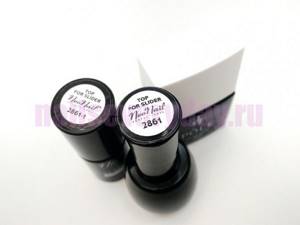
NeoNail Top for Slider and Pole thick top for fixing volumetric decor
These topcoats are designed to secure the decor. They produce tops for sliders, for rubbing, for attaching rhinestones, bouillons, etc. All their properties are best selected to solve a specific problem. For example, the finish for fixing volumetric decor will be without a sticky layer, thick and as transparent as possible. The slider top will be medium thick, with a very sticky dispersion and a little yellowish (which is okay). Typically, such coatings are not used as basic and universal ones.
Decorative tops for gel polish
Decorative gels include finishing gels, to which manufacturers have carefully added various decorative elements. For example, there are both glossy and matte finishes, which contain a variety of glitter, yuca flakes, magnetic cat-eye pigment, different-sized white and black flakes to create the effect of a quail egg, reflective particles, dried flowers, gold leaf, mother-of-pearl, camouflage pigment, etc. We recommend checking how even and smooth the surface of such a top coat polymerized on the nail is. If decorative elements protrude, then it is better to lightly go over the surface with a buff, degrease and cover with another layer of your usual, favorite topcoat.
Tips on how to secure it for a long time
To add shine and richness, simply cover your nails with one layer of fixative. If you are aiming for a lasting result, the design should be performed in a certain order. In order for a regular decorative coating to last for a long time, the plate must be prepared as much as possible, and sometimes even the natural gloss must be removed for good adhesion of all components.
To make the coating last longer, it is better to apply layers as thinly as possible. It is necessary to ensure that there is no bleeding onto the side ridges or the root part of the nail. The first thing that happens is that the top layer begins to chip off at the end. To prevent chipping in the toe, it is better to also apply the fixative along the end of the nail, thereby completing the coating.
Frequently asked questions or FAQ for beginners
Which top coat for gel polish is better?
The one that is more convenient to work with and copes with the tasks that you set for it. Uno Supershine is recognized by craftsmen as almost universal: without a sticky layer, elastic, medium in thickness, has a bright gloss, rubs off slowly, does not bluish much, does not yellow much, does not bubble, dries quickly, you can rub rubs into it and fix small decor with it.
Why does the top fit with bald spots?
There are several reasons for this. This often happens when covering with a top coat without l/s in two layers, or applying it over a gel paint without l/s, or when applying a matte finish to a finish without l/s. This may also be due to sebum or cosmetics getting on the surface to be coated - degreasing it with nail prep will help. Or the colored gel polish you are applying the top on has too much greasy dispersion - then remove the sticky layer and try again. Or, on the contrary, the color/paint/finish has no dispersion and the material rolls off a too smooth surface - then lightly buff the color to make roughness appear. And also, one should not rule out simply the low quality of the material, especially purchased from Chinese online stores.
Is it possible to apply gel polish and gel paint to the top?
Can. But it is better to choose a top coat with residual stickiness for such techniques, remove the stickiness and paint on top with gel polish or gel paint in a not too thin layer, otherwise chips are possible. If you need to completely cover the finish on top with colored gel polish, then first buff it, degrease it, and then cover it. And cover the top again with a layer of sealer.
Rubber top for gel polish. What is it and why
These are very thick materials with good adhesion. They are suitable for fixing volumetric decor, but are not convenient for completely covering nails, as they spread slowly and self-level.
Is it possible to use a top instead of a base?
No need. These materials are created to solve different problems. The base ensures adhesion to keratin, strengthening the natural nail, and the finish fixes the color and prevents it from fading in the sun and rubbing off under mechanical stress. They are not interchangeable.
Hypoallergenic top for gel polish
Any artificial material can cause allergies. Its risk can be reduced due to its quality and lack of contact with the skin. Choose a top without residual dispersion from the premium segment.
How to replace top coat for gel polish
Single-phase transparent gel (it will be hard) or single-phase 3 in 1 gel polish. In a three-phase system, base, color and top are not interchangeable.
What about the price?
If you are going to regularly apply gel polish, then it is much more profitable to buy everything you need and do it yourself at home. The lamp and materials will pay for themselves within a few uses.
Prices for lamps have long ceased to be so exorbitant, and when their girlfriends see such a device, they will immediately sign up for a manicure :)
The cost of gel polish in online stores largely depends on the manufacturer’s brand. There are cheap gel polishes, and there are premium materials - choose what suits your budget. On average it is 500 Russian rubles. On my blog you will find many reviews and reviews of different brands. Here I have everything, bye-bye :)
